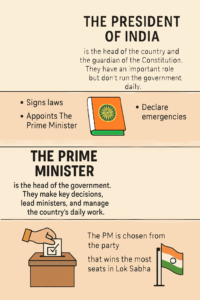Leaders of India: Presidents and Prime Ministers from 1947 to Today
In India, the President is the official head of the country. Think of the President as the guardian of the Constitution, who makes sure that all rules and laws are followed properly. Although the President doesn’t manage the daily work of the government, they have important responsibilities like signing new laws, appointing the Prime Minister, and even declaring emergencies when needed. It’s mostly a ceremonial role, but still very important for keeping the system balanced.
On the other hand, the Prime Minister is the real leader of the government. The PM makes major decisions, leads the different ministers (like Finance, Education, Health), and runs the country on a daily basis. The Prime Minister is chosen from the political party that wins the most seats in the Lok Sabha (the lower house of Parliament). So, while the President is the symbol of the country, the Prime Minister is the one who actually runs the show.

Presidents of India
| No. | Name | Term | State Represented | Notes |
|---|---|---|---|---|
| 1 | Dr. Rajendra Prasad | 1950–1962 | Bihar | First President, served 2 terms |
| 2 | Dr. S. Radhakrishnan | 1962–1967 | Andhra Pradesh | Philosopher, former Vice President |
| 3 | Dr. Zakir Husain | 1967–1969 | Uttar Pradesh | First Muslim President, died in office |
| 4 | V. V. Giri | 1969–1974 | Odisha | Only President elected as independent |
| 5 | Fakhruddin Ali Ahmed | 1974–1977 | Delhi | Died in office |
| 6 | Neelam Sanjiva Reddy | 1977–1982 | Andhra Pradesh | Former Speaker of Lok Sabha |
| 7 | Giani Zail Singh | 1982–1987 | Punjab | First Sikh President |
| 8 | R. Venkataraman | 1987–1992 | Tamil Nadu | Served during political transition |
| 9 | Dr. Shankar Dayal Sharma | 1992–1997 | Madhya Pradesh | Former Vice President |
| 10 | K. R. Narayanan | 1997–2002 | Kerala | First Dalit President |
| 11 | Dr. A. P. J. Abdul Kalam | 2002–2007 | Tamil Nadu | Renowned scientist, “People’s President” |
| 12 | Pratibha Patil | 2007–2012 | Maharashtra | First woman President |
| 13 | Pranab Mukherjee | 2012–2017 | West Bengal | Veteran politician |
| 14 | Ram Nath Kovind | 2017–2022 | Uttar Pradesh | Former Governor of Bihar |
| 15 | Droupadi Murmu | 2022–Present | Odisha | First tribal woman President |
🇮🇳 Prime Ministers of India
| No. | Name | Term | State Represented | Notes |
|---|---|---|---|---|
| 1 | Jawaharlal Nehru | 1947–1964 | Uttar Pradesh | First PM of India |
| 2 | Gulzarilal Nanda (Acting) | 1964 | Punjab | Interim PM after Nehru |
| 3 | Lal Bahadur Shastri | 1964–1966 | Uttar Pradesh | Gave slogan “Jai Jawan, Jai Kisan” |
| 4 | Indira Gandhi | 1966–1977, 1980–1984 | Uttar Pradesh | First and only female PM |
| 5 | Morarji Desai | 1977–1979 | Gujarat | First non-Congress PM |
| 6 | Charan Singh | 1979–1980 | Uttar Pradesh | Brief tenure, no parliamentary majority |
| 7 | Rajiv Gandhi | 1984–1989 | Uttar Pradesh | Youngest PM, promoted technology |
| 8 | V. P. Singh | 1989–1990 | Uttar Pradesh | Implemented Mandal Commission |
| 9 | Chandra Shekhar | 1990–1991 | Uttar Pradesh | Short-lived government |
| 10 | P. V. Narasimha Rao | 1991–1996 | Andhra Pradesh | Liberalized Indian economy |
| 11 | Atal Bihari Vajpayee | 1996, 1998–2004 | Uttar Pradesh | Led India during nuclear tests & Kargil War |
| 12 | H. D. Deve Gowda | 1996–1997 | Karnataka | Former CM of Karnataka |
| 13 | I. K. Gujral | 1997–1998 | Punjab | Known for “Gujral Doctrine” |
| 14 | Dr. Manmohan Singh | 2004–2014 | Assam (Rajya Sabha) | Renowned economist, led UPA government |
| 15 | Narendra Modi | 2014–Present | Gujarat | Focus on development, digital India |
Summary :
The President of India is the head of the country and the guardian of the Constitution. They have an important role but don’t run the government daily. Their duties include signing laws, appointing the Prime Minister, and declaring emergencies.
The Prime Minister is the head of the government. They make key decisions, lead ministers, and manage the country’s daily work. The PM is chosen from the party that wins the most seats in the Lok Sabha.
Tags: appoint Prime Minister, Atal Bihari Vajpayee nuclear tests, ceremonial role, Chandra Shekhar, Charan Singh, declare emergencies, Digital India, Dr. A. P. J. Abdul Kalam, Dr. Manmohan Singh economist, Dr. S. Radhakrishnan, Dr. Shankar Dayal Sharma, Dr. Zakir Husain, Droupadi Murmu, Fakhruddin Ali Ahmed, first and only female Prime Minister Indira Gandhi, first Dalit President, first Muslim President, first President Rajendra Prasad, first Sikh President, first tribal woman President, first woman President, Giani Zail Singh, Guardian of Constitution, Gulzarilal Nanda acting PM, H. D. Deve Gowda, head of government, I. K. Gujral Gujral Doctrine, India 1947 to Today, Indian Government, Jawaharlal Nehru first Prime Minister, K. R. Narayanan, Lal Bahadur Shastri, lead ministers, Leaders of India, Lok Sabha majority, major decisions, Morarji Desai first non-Congress PM, Narendra Modi development, Neelam Sanjiva Reddy, P. V. Narasimha Rao economic liberalization, Pranab Mukherjee, Pratibha Patil, President of India, Presidents, Prime Minister of India, Prime Ministers, R. Venkataraman, Rajiv Gandhi youngest PM, Ram Nath Kovind, run country daily, sign laws, slogan Jai Jawan Jai Kisan, V. P. Singh, V. V. Giri


